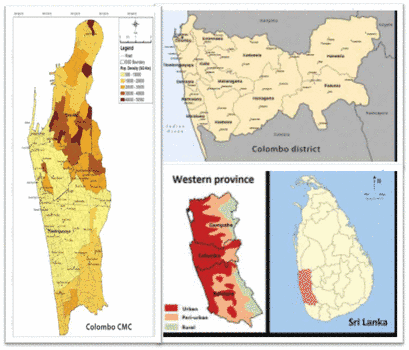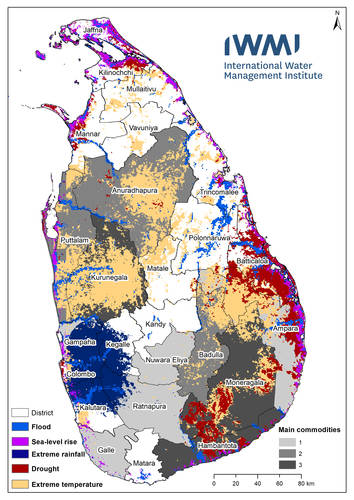Colombo, Sri Lanka
Background
Colombo, the largest city and financial hub of Sri Lanka, occupying an area of 37 km2, and home to an estimated 612,535 inhabitants (2020) and nearly another 500,000 daily floating population. Its overall population density is 13,364 persons/km2 (country’s average population density is 325 persons/km2).
The trend of urbanization in Colombo is expected to increase the overall population where the city and its neighbouring urban areas are facing fast-growth resulting in a merge of these areas, while the Colombo Port City is expected to add another 75,000 inhabitants and 175,000 daily commuters in 25 years. Over fifty percent of the city population live in slums or dilapidated old housing schemes, occupying nine percent of the total land extent of the city (Urban Development Authority, Ministry of Megapolis & Western Development, 2018).
The city region food system (CRFS) of Colombo
The city region food system (CRFS) of Colombo has been defined based on a set of criteria:
- Built up areas and population density where less dense areas of the region act as suppliers to the city of Colombo.
- Jurisdictional and administrative boundaries - governing units that take policy decisions.
- Supply areas of macro and micronutrients of the most important commodities, which supply macro and micro (vitamins and minerals) nutrients to the Colombo city region. In this case, rice for carbohydrate, fish for protein, coconut for fat, and fruit and vegetables for vitamins and minerals.
- From a geographical viewpoint, the Colombo city region has been defined as the Colombo district area including the Municipal Council (CMC).

Key food commodities
The CRFS project has consulted different sources to identify what makes up the average diet for people in the Western Region Megapolis (WRM).
The average diet consists of rice as the main source of carbohydrates, fish and beans as well as other legumes for proteins, coconut (mainly used for fat), while fruits and vegetables are the main source of vitamins.
Main climate hazards impacting the CRFS
Main hazards (shocks and stresses) affecting the CRFS
The food system of the Colombo city region is exposed to climate related hazards such as floods, droughts, extreme air temperatures, rising sea levels, and extreme rainfall patterns. These impacts are further exacerbated due to the existing trends of unsustainable agricultural practices on soils - already deficient of organic matter.
- Floods have been a common occurrence in Sri Lanka, with predictions that their frequency will only increase in the coming decades (USAID, 2018; Eriyagama et al., 2017). In the last four years, Sri Lanka was hit by two major floods, those of May 2016 and 2017, affecting a total of 493,000 and 880,000 people respectively. The aftermath resulted in the loss of hundreds of lives, destruction of thousands of homes, the inundation of lowlands, and landslides.
- Droughts have a significant impact on the livelihoods of Sri Lankans, in particular farmers. They incur the highest economic damage compared to any other natural disaster (Burchfield and Gilligan, 2016). Extended dry spells lead to large losses in crop production.
- Extreme temperature: The AR4 and AR5 predict that temperature levels are expected to continue to rise in South Asia, where they are already higher than the global mean (IPPC, 2014). Studies suggest that a decrease in rainfall could account for an increase in extreme temperature with a direct impact on staple food crops that are particularly sensitive to changes in air temperature (USAID, 2018).
- Sea levels rise: While exact projections for the future vary, many researchers agree that the sea level rise in South Asia has seen an acceleration in recent years (Murali et al. 2013; IPPC, 2014; USAID, 2018). People living in the coastal regions of Sri Lanka are highly vulnerable to sea level rise as this leads to coastal erosion, salinization of groundwater reserves, and saltwater intrusions on fertile strips of land situated near the coast (Werner et al., 2013).
- Extreme Rainfall: Despite negative trends being observed for various regions and rainfall seasons across Sri Lanka, the intensity and frequency of extreme climate events related to rainfall has increased and is predicted to increase further (Eriyagama et al., 2010). “Changing rainfall patterns and unexpected periods of high rainfall are expected to strain the capacity of irrigation systems and increase the risk of landslide in some areas.” (Koresawa et al. 2018).

Main impacts on the CRFS
These hazards can have negative effects on all parts of the food system. For the CRFS of Colombo, the traditional channels of paddy, coconuts, fish and most fruits and vegetables are vulnerable to oscillating climate conditions and extreme weather events (Esham et al. , 2018).
Production
Over the years the frequent occurrence of floods has affected paddy production in Sri Lanka with heavy damages recorded during the Maha season in 2008 and 2009, resulting in a peak of flood incidences in December and March. High-temperature injuries in rice are also inevitable if the plant is exposed to an ambient temperature that exceeds 33°C just for 60 to 90 minutes at the flowering stage (Nissanka et al., 2011; Marambe et al., 2015). In 2012, the drought completely destroyed 300 000 ha of rice paddy while the 11-month drought in 2014 reduced agriculture production by around 40 percent (OCHA, 2014), including rice - with about 30 percent crop losses recorded in the Northern Province (OCHA, 2014). Furthermore, the decreasing trend of diurnal temperature range is likely to cause negative impacts on the root and tuber crop production in the country, especially potato production in the central hills (Marambe et al., 2015).
Storage and processing
Significant post-harvest losses in paddy production occur as a result of poor post-harvest handling, storage and poorly organised rice marketing channels. A secondary cause for post-harvest losses bearing significant weight is the unpredictability of rainfall patterns as this affects grain threshing and drying, both processes requiring dry conditions (Esham et al., 2018). A general lack of storage facilities also contributes to post-harvest losses along the rice marketing channels. The Paddy Marketing Board (PMB) - the government’s paddy purchasing body has only 180 storage facilities, many of which are in poor condition (Senanayake and Premaratne, 2016). Further losses can also be attributed to the rise in temperatures and the increasing occurrence of extreme weather events. Increased temperatures decrease the shelf life of fruits and vegetables and exacerbate the losses of perishables.
Transport and distribution
Within the city region of Colombo there are two well-established branded supermarket chains, and 18 large-scale markets including the Manning Market (FAO, 2018). There are four dedicated economic centres within the city of Colombo. Due to the limited number of dedicated economic centres in the city, the CRFS of Colombo is quite vulnerable to climate-related shocks, as one extreme event (such a rainfall or flood) can disrupt the entire supply chain. Projected rises in temperatures will incur further post-harvest losses on retail stalls and open-air markets with no refrigeration (Esham et al., 2018).
Food consumption
The impact of climate change on food prices in South Asia have a negative impact on both food production and prices. For a country like Sri Lanka - very dependent on the agricultural sector, food price instability and food shortages can seriously affect consumption (Bandara and Cal, 2014). As described (Esham et al., 2018), low-income, food insecure households follow a common strategy of skipping or reducing the quantity of a meal when there is an escalation in food prices.
Climate shocks, particularly floods and cyclones have an impact on food losses due to crop failures and the disruption of the supply and system. In Sri Lanka, floods or collapsed landfills, waste collection can be seriously hampered and cause public health issues. A different sort of waste, but also likely to threaten public health because of climate change related hazards is wastewater (black water). The structures in place for the collection, treatment and disposal should be flood-proof in order to avoid public health risks.
The impacts of COVID-19
The COVID-19 pandemic related restrictions led to a lack of movement between districts nationally. As a result, Colombo’s supply of upcountry vegetables was seriously affected. Vegetable prices quadrupled, while ocean fish supply dropped 75 percent. Mainstream supply chains, which serve the middle- and low-income communities, needed approximately two months to recover (RUAF, 2020). The government of Sri Lanka in its desperate efforts to revive the ailing economy, gave several directives to the agriculture sector even during the two-month lockdown period such as allowing the farming community to continue farming operations and allowing the establishment of private-public partnerships to provide door-to-door delivery of food items, e-auction of coconut, etc. (Marambe and Silva, 2020). The private sector also launched online marketing platforms and home delivery systems to enable food availability and access to consumers.
Priorities identified to increase the resilience of the CRFS
Preliminary priority areas have been identified and will deserve more in-depth analysis. The priority areas identified are:
- food production: interventions to increase resilience such as urban agriculture, etc.
- food supply and distribution: innovative and alternative (short) value chains and models, including food loss reduction
- food consumption: price sensitivity, nutrient sensitivity of vulnerable groups
- governance, including National priorities from a CRFS perspective.
Stakeholder inputs from consultative sessions and intermittent analyses during the investigative process are expected to lead to specifics on climate change implications and focused prioritization.












